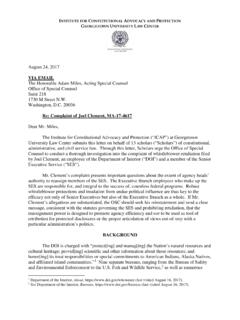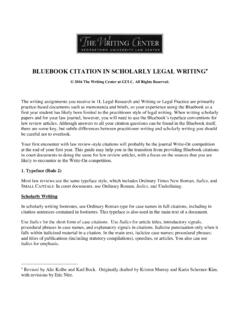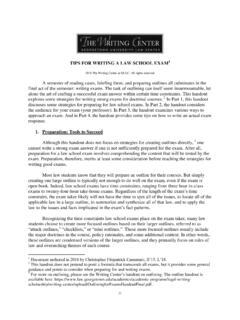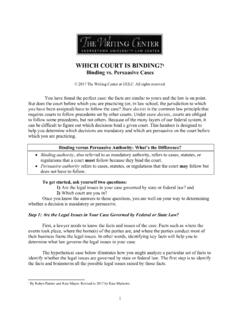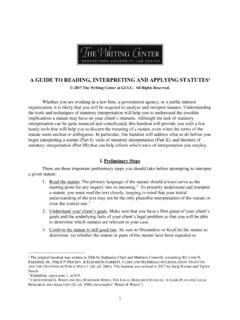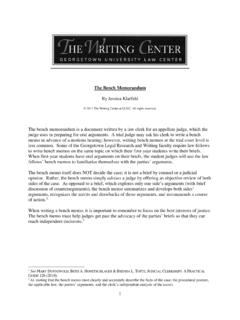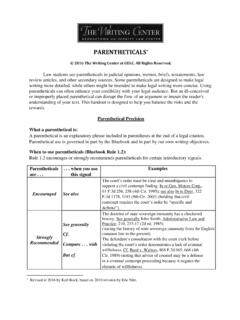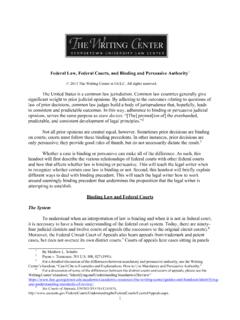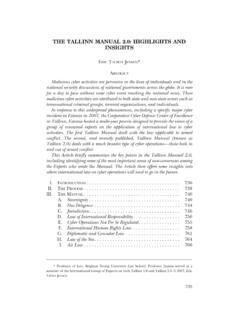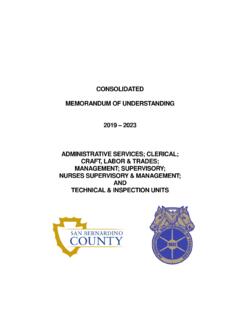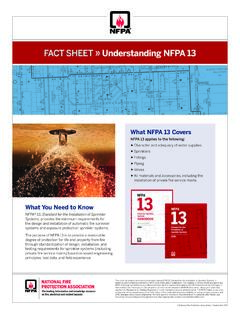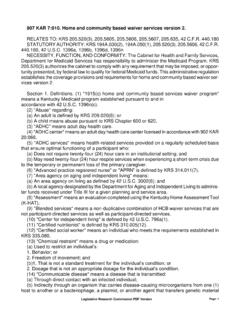Transcription of Identifying and Understanding Standards ... - Georgetown Law
1 1 Identifying AND Understanding Standards OF REVIEW1 2019 The Writing Center at GULC. All rights reserved. To determine whether you have a viable issue to appeal, one of the first issues you must consider is the applicable standard of review. Identifying the applicable standard of review is essential because it may determine whether an issue is likely to be successful or even arguable. For many issues, the standard of review is clearly defined by case law or by statute. In other situations, however, the appropriate standard may be undecided. When working on appellate matters, you should seize any opportunity to persuade the court of appeals to apply a standard of review that is the most beneficial for your position. When determining the standard of review applicable to your appeal, the key is to research how courts of appeals in your jurisdiction review your type of appeal.
2 This handout presents the typical approach to Standards of review, but it is critical to remember that courts vary widely, so you must do your own research of the case law specific to your issue. Further, Standards of review are best understood as a continuum and lack clear boundaries, so research can help determine how your court will approach this continuum. This handout will help you understand why there are different Standards of review, what the differences with each standard are, the issues of mixed questions of law and fact, and some of the ways you can write about the standard of review in a brief. WHY DO DIFFERENT Standards OF REVIEW EXIST? Standards of review are drawn from the limited role of the appellate court in a multi-tiered judicial system. Trial court judges generally resolve relevant factual disputes and make credibility determinations regarding the witnesses testimony because they see and hear the witnesses testify.
3 Whereas, appellate judges primarily correct legal errors made by lower courts, develop the law, and set forth precedent that will guide future cases. Appellate courts also sit in panels on the theory that three or more judges, acting as a unit, are less likely to make an error in judgment than one judge sitting alone. Structurally, it means that it takes at least two court of appeals judges to overturn a decision of a lower court, signifying that a single court of appeals judge does not have the power to reverse a single trial court judge. Because of these differences in the trial and appellate functions, appellate courts accord varying degrees of deference to trial judges rulings depending on the type of ruling that is being 1 Revised by Julia Rugg in 2019. Previous versions of this handout were written by Daniel Solomon, and Mary Calkins & Matt Hicks.
4 2 reviewed. These varying levels of deference are known as Standards of review. Besides providing the justification for Standards of review, these theories of institutional competence can also be used persuasively in a brief to argue for a certain standard of review or for the standard to be applied a certain way. WHAT ARE THE DIFFERENT Standards OF REVIEW?2 There are six basic Standards of review which span a continuum of no deference to the lower court (de novo) to complete deference to the lower court (no review). The standard of review applied will generally be based on the type of ruling up on appeal and the decisionmaker below. The table below summarizes where the main Standards of review fall on the deference continuum, and some of the areas where each standard of review may T he sections that follow provide an overview of each standard.
5 Deference Continuum No Deference Minimal Deference Some Deference More Deference More Deference Complete Deference Standard of Review De novo Clearly erroneous Reasonableness/ Substantial Evidence Arbitrary and capricious Abuse of discretion No review When it Applies Quest ion of law Question of fact Jury decision Formal agency decisio n Informal agency decision Discretionary decisio n Some agency actions Decisio n to not prosecute I. De novo Questions of law are reviewed de novo. Because courts of appeals are primarily concerned with enunciating the law, they give no deference to the trial court s assessment of purely legal questions. For example, a question of constitutional interpretation or the meaning of particular terms in a statute is a question of law. As an appellant, if there is any opportunity to do so, you should try to characterize the lower court ruling as a mistake of law because you can then start with a clean slate and lessen the disadvantage of losing below.
6 Note that in some situations both law and fact findings from an administrative proceeding can be reviewed de novo, so it is important to check the statute providing for the review of that proceeding. 2 Unless otherwise cited, the concepts in this section were adapted from Martha S. Davis, A Basic Guide to Standards of Judicial Review, 33 L. REV. 469 (1988). 3 This table is a simplified to present a general roadmap of the types of standard of review. For a more detailed version that breaks down the type of decision and decision maker, see Davis, supra note 2, at 468. 3 II. Clearly Erroneous Questions of fact are reviewed under the clearly erroneous standard. This standard is based on the proposition that the trial judge has presided over the trial, heard the testimony, and has the best Understanding of the evidence.
7 Thus, lower courts receive substantial, but not total, deference. 4 The Supreme Court defined the standard as: A finding is clearly erroneous when although there is evidence to support it, the reviewing court on the entire evidence is left with the definite and firm conviction that a mistake has been committed. 5 But, if there are two permissible outcomes, the trial judge s choice is not clear error, even if the reviewing court may have come to a different conclusion. It is very difficult to overturn a trial court s factual determination, so if your appeal rests solely on a challenge to a finding of fact, the likelihood of success will be low unless the circumstances are egregious. In practice, you may have more success persuading a court of appeals to overturn a finding based on documentary evidence, such as a question of contract interpretation, than a finding based on testimony because the appellate judge is in just as good a position to review the document as the trial judge.
8 Nevertheless, this is still a difficult argument to make because the trial court s traditional role as fact-finder is sufficient basis alone for deferring to the trial court on findings from documents. Note that the clearly erroneous standard is only applied to fact finding by judges, masters, and sometimes magistrates. Fact finding by a jury or administrative agency is reviewed under the reasonableness or substantial evidence standard. III. Reasonableness/Substantial Evidence The two main types of proceedings subject to a reasonableness or substantial evidence standard are jury and agency decisions. A. Jury decisions The Seventh Amendment places great constraints on a court s authority to overturn factual findings made by a jury. Thus, jury fact findings and other decisions are given great deference by reviewing courts. The reasonableness standard of a jury verdict is generally for the verdict to stand unless no substantial evidence supports the decision.
9 An appellate court must reverse a conviction if, after viewing the evidence in the light most favorable to the verdict, it finds no rational trier of fact could have found the essential elements of the crime beyond a reasonable doubt. 6 4 Davis, supra note 2, at 476. 5 United States v. United States Gypsum Co., 333 364, 395 (1948). 6 Jackson v. Virginia, 443 307, 319 (1979). 4 B. Agency decisions The administrative Procedures Act (APA) provides substantial evidence review for formal agency actions. The application of a reasonableness or substantial evidence standard to administrative proceedings varies in how much deference is afforded. For example, if an agency is seen as performing functions like a court then the standard will operate similar to clearly erroneous review.
10 But if an agency is seen as operating not like a court and rather as using its particular expertise, then reasonableness review will look more like the review of jury decisions. Note that when reviewing agency statutory interpretation or policymaking, courts may describe the review as rational basis review or hard look review, which are just kinds of substantial evidence review. IV. Arbitrary and Capricious Under the APA, informal agency actions are reviewed under the arbitrary and capricious standard. Initially this was a very deferential standard because agency fact finding or policy decisions did not require much of a record. However, as courts began requiring a more substantial record, the arbitrary and capricious review became less deferential. The major difference in arbitrary and capricious and reasonableness/substantial evidence Standards is what the appeals court reviews: In substantial evidence review, the review encompasses the agency's assessment of the evidence in the record and its application of that evidence in reaching a decision.
